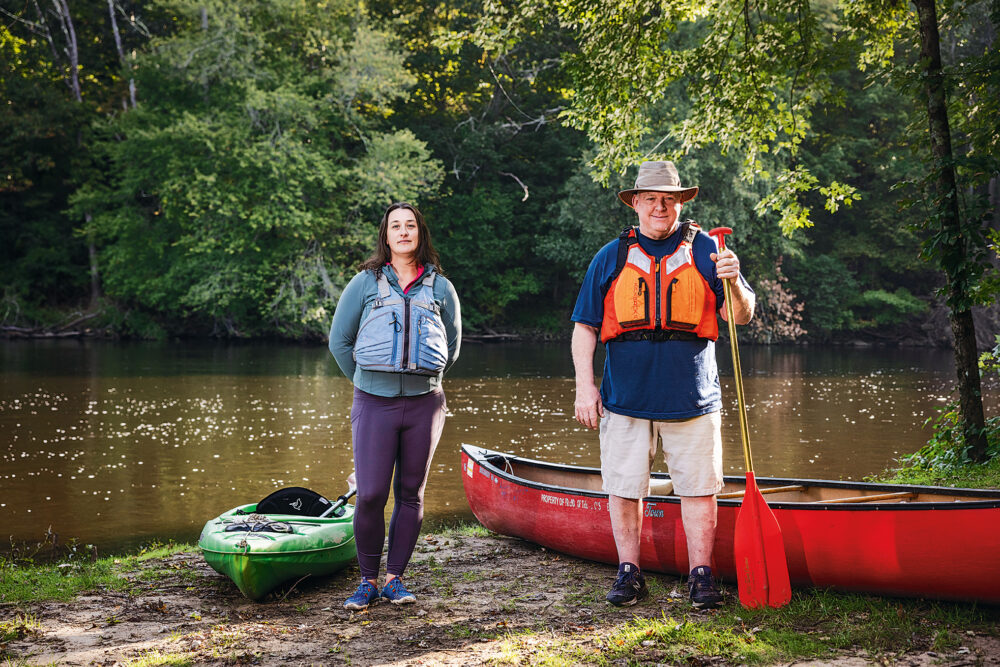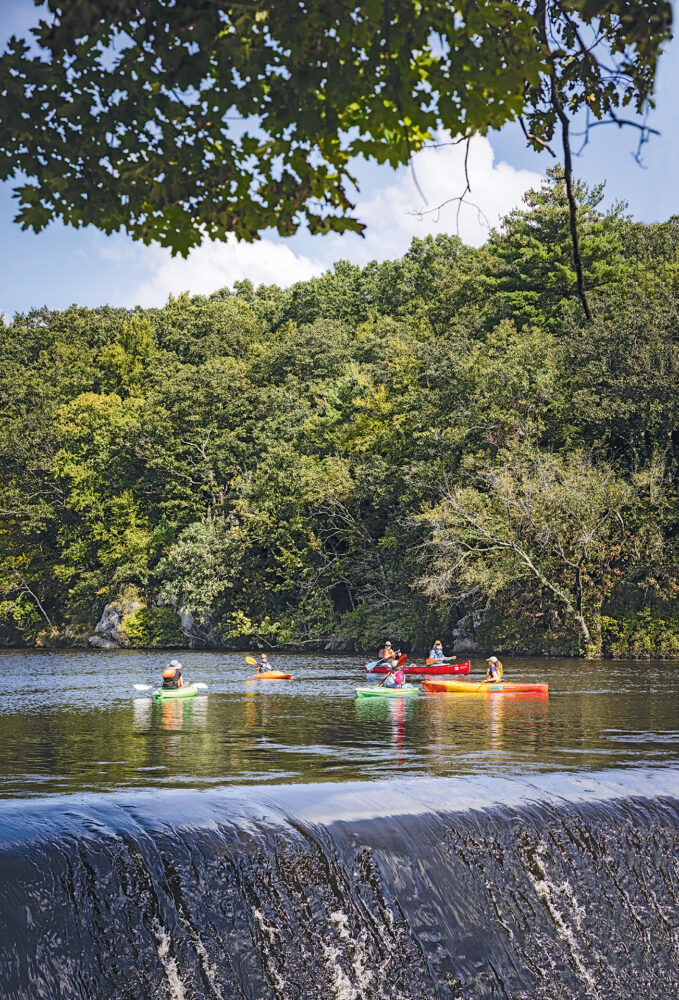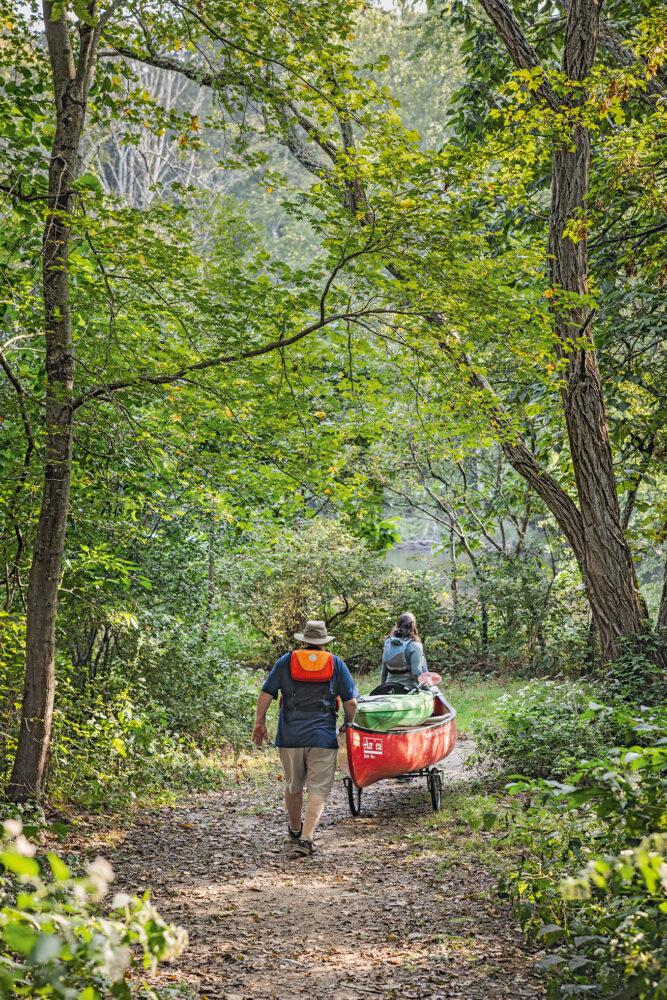Exploring the Blackstone
Local groups seek to demystify access to the river to help others enjoy its hidden beauty
By Colleen Cronin | Photographs by Jesse BurkeThe Blackstone River sometimes gets a bad rap.
Like many New Englanders, natural beauty and majesty weren’t the first things I thought of when I was first assigned to paddle the Blackstone River for a story two summers ago. The birthplace of the American Industrial Revolution, the Blackstone was once famously known for changing colors depending on what dyes the mills that lined its banks were using at the time.
Today, efforts to restore the 48-mile river to its pre-Colonial conditions have made the river bucolic. The problem is getting there. There are few safe access points on the Blackstone where people can get to the water to fish or hop in a boat.
On a scale from one to 10, Blackstone Watershed Collaborative Program Manager Stefanie Covino rates access to the river at about a four.
“If you want to do it, you could do it,” she explains. “But man, do we have a lot of room for improvement.”
I set off with Covino and a group of river advocates to kayak the Blackstone again on a crisp September morning last fall to learn more about access challenges on the river and efforts to solve them.
We start at one of the best access points the Blackstone has: Sycamore Landing, the Blackstone River Watershed Council/Friends of the Blackstone property in Lincoln. Arriving at the site early and a little sleepy, I don my urban sombrero and pick out a life vest. President and founder of Friends of the Blackstone John Marsland helps me choose a kayak from the boathouse on the property.
Walking down a little path from the building, pushing our boats on dollies, we see glimpses of the Blackstone peeking out from the trees. In this spot, it doesn’t roar. It glides around a bend south towards Pawtucket and Central Falls.
Stefanie Covino, program manager for the Blackstone Watershed Collaborative, and John Marsland, president and founder of Friends of the Blackstone, get ready to paddle on the Blackstone River.

It’s the perfect place to launch a boat along the riverbank easily and safely. The organization runs a paddling program for the public, and the access point on the property is a better place to get folks with differing mobilities in the water than other spots along the river.
Heading south with the current, the group follows along the bank and the Friends of the Blackstone property, where benches and large trees, including a towering sycamore, line the river. Marsland tells me that before the property became a nature preserve, it was a junkyard.
“A 20-year project,” Marsland calls it, describing the people power it took to remove old piles of asphalt and trash. Then, there was the invasive knotweed they had to fight over and over until they’d beaten it down enough to plant pasture grass.
The stretch of the river after Sycamore Landing feels easy and peaceful. Going with the water flow, sometimes I pull my paddles up and sit back to watch the sparrows flit between riverbanks or turtles bask in the fallen limbs that drape over the Blackstone’s edges.
The leaves turn autumn shades a little quicker near the water, so by our late September run, golden and reddish hues have started to appear in the foliage.
While we paddle, I catch up with Covino and Emily Vogler, an associate professor of landscape architecture at the Rhode Island School of Design and creator of the Blackstone River Commons, a project to support river stewardship. All is well and good until we hit the Albion Dam. About two miles down the river from Sycamore Landing, you may not realize the hydropower structure is there until you start to hear it or you are already going over the dam.
I hear the story of how Friends of the Blackstone Restoration Coordinator Keith Hainley accidentally made it over the dam in a canoe. He’d been cleaning up some trash on the river and suddenly found himself listing over. Hainley was fine, but Covino and Vogler warned me not to get too close. We need to get out of the water to continue our journey, and the access point by the dam and the Blackstone River Bikeway is more challenging than Sycamore Landing.
Dams can be a challenge for paddlers on the Blackstone River.

I scooch my kayak as close to the land as I can, wedging it in between some roots in the shallow water to try to moor my boat. I place my paddle inside the boat—I know I’ll need both arms—before standing up very slowly, finding my balance, and finally working up my courage to leap onto the steep bank that is more washed-out gully than path. Once Covino and I are out, we help each other haul the boats up to the parking lot of the bike path and into her truck. Ironically, Covino says, “It’s easier to drive over [the Blackstone] than it is to sit by the water.” About 20 minutes and a Dunkin Donuts stop later, we arrive at Elizabeth Webbing Mills Dam in Central Falls.
We started the process of lugging boats and paddles back out of Stefanie’s truck bed and towards the water, and I felt nervous as I looked for where we could possibly plan to enter the river. Although I’ve paddled the river before, I’d never managed to hop in Central Falls’ portion. Covino didn’t hesitate as she marched over to the water’s edge, where a sitting area with a bird feeder for the condo complex we’d parked in met riprap and at least a 10-foot drop into the river.
When Covino had paddled the Blackstone two years before, she’d had to porter their boats around the dam and down the rocky edge. Avoiding poison ivy as best she can, Covino shows me how she had lowered herself and her boat, rock by rock, to finally start paddling.
Luckily for me, since I’m highly allergic to poison ivy, Covino doesn’t expect me to follow her into the water; she only asks for a little help coming back up. Back on dry land, I marvel at what she’s just done and that it’s the “best” option for getting into the area. Covino and I pack the canoes back in her truck, and as she closes the gate, she raises her eyebrows as if to say, “it’s not great, right?”
Since September, I’ve thought a lot about that paddle and how things could change for the better. So, I recently called Covino and Vogler to ask them what they think a more accessible Blackstone might look like.
With such varied access, Vogler and Covino say it makes sense that people don’t always take advantage of the river—it’s hard to know how to.
Vogler recently finished creating a map of 18 river access points. The majority of those spots are improved access points, she says, and include both Sycamore Landing and the entrance to the river just before the Albion Dam. The Elizabeth Webbing spot, however, isn’t on the map. Even though Vogler and Covino have used it before, along with several other unofficial access points, that doesn’t mean they would recommend it. “We wouldn’t list that as a like, ‘You should go to the back of this parking lot and put your boat in,’ or, ‘You should, you know, trek through this however-long, unmarked path of poison ivy and find your way down to a steep bank,’” Covino explains. The listed access points are “more clear and permanent,” she adds.
A new map will help paddlers find river access sites that are easy to navigate.

Vogler hopes people can use the map to help guide their own paddles or river visits. In addition to a printed version, she says they’ll also put the map online and create a StoryMap version that is more interactive “because there’s only so much that you can include in a poster.”
Covino wants to enable users to report things like where they found invasive water chestnuts on the river or unlisted access points.
In addition to the map, Covino would like to see better signage and improved accessibility for existing access points, as well as more signage and portages around dams.
The different parts of the river also offer different challenges. Rhode Island’s portion has more access points than Massachusetts’, Vogler says, but it also has more dams that force people out of the water. When Covino and Vogler did a river-long paddle, they saw others on the water but few people in stretches around Central Falls and other places where access issues and obstructions can make the river seem daunting.
Vogler hopes the map will “demystify a little bit of those impediments that may prevent people from feeling like they can access the river.”
“Once you wrap your head around it, it’s an amazing river to explore,” she adds. “Next time we paddle, hopefully, we’ll see others out there as well, exploring.”
Narragansett Bay Estuary Program
This issue is supported by the Narragansett Bay Estuary Program (NBEP), a nonprofit organization led by stakeholders that pursues place-based conservation across the three-state Narragansett Bay region.
With its 30-member partnership, NBEP catalyzes scientific inquiry and collective action to restore and protect the region’s water quality, wildlife, and quality of life.
This issue of 41°N highlights several of the stories and partners driving a 10-year blueprint to realize their vision of clean water and habitat to sustain all who live, work, and play in the Narragansett Bay region.
